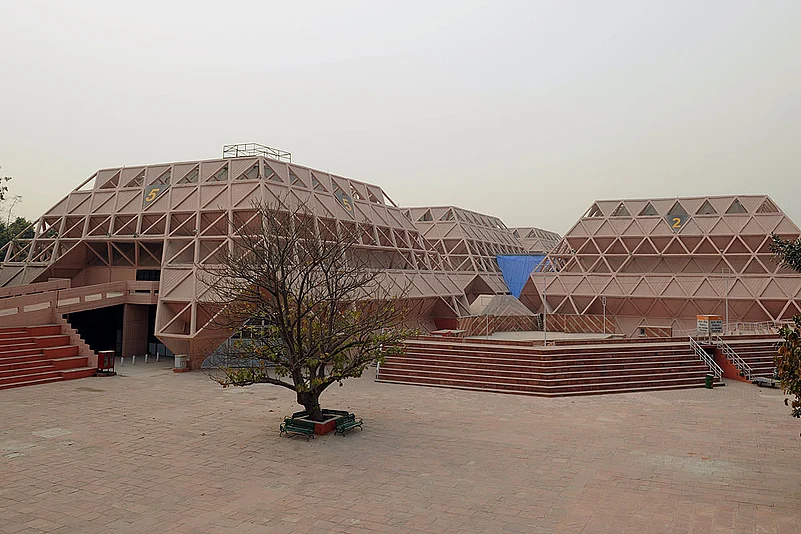Its imprint on the Delhi skyline as distinctive as it gets, the Hall of Nations at Pragati Maidan is widely seen as an iconic representation of modern Indian architecture. The space-frame octahedron structure, with trusses splayed out in visually dynamic lines, was built in 1972 as part of celebrations to mark 25 years of India’s independence and to mark the country’s arrival as a global exhibition space for industrial goods. Its architect, Raj Rewal, opted for reinforced concrete instead of tubular steel frames then popular in American and European architecture, and labour-intensive construction methods instead of technology-driven ones. The logic was simple: steel was scarce and expensive in India but labour was abundant.
Thirty-four years on, the structures of Pragati Maidan, now imbued with a period charm, face the threat of imminent demolition. In the “complete makeover drive” spearheaded by the India Trade Promotion Organisation (ITPO), the reinforced concrete could make way for new ones made of steel and glass—the current, much-abused fetish. ITPO officials say there is a need for a state-of-the-art exhibition and convention centre in the heart of Delhi and the buzz is ‘Shanghai-type buildings’ would come up on those 150 acres abutting the historic Purana Qila and Matka Pir (shrine of Hazrat Sheikh Abu Bakr Tusi). What would be lost in the bargain is the architectural and historical eminence of the Hall of Nations, the Hall of Industries and the Nehru Pavilion. It would mean losing a bit of our collective cultural memory, one strand of the story of how a modern ethos was shaped in India in visual form.

Cold Concrete The architects chose reinforced concrete over steel (Courtesy: Raj Rewal)
Inaugurated by then prime minister Indira Gandhi on November 3, 1972, Pragati Maidan has hosted numerous book fairs, trade fairs and auto expos over the years. Along with engineer Mahendra Raj, architect Rewal designed a triangulated cluster of buildings on the exhibition grounds, allowing a touch of Nehruvian nationalism to the square plan of the space frame. They used the walls as sun-breakers with a distant resemblance to lattice work. Chamfered corners with symmetrical sloping edges were a nod to Mughal architecture, inspired by Humayun’s Tomb and the Taj Mahal.
“It was designed to symbolise what India could do,” says Rewal, barely concealing his dismay. “The methodology was dynamic so that everything from tractors, bulldozers and cranes to books and textiles could be suitably displayed in that space.” Engineer Raj admits it makes no sense to demolish a structure that has stood the test of time and earned international recognition. Also, there has been no real public consultation or engagement with the community on the plan.
A petition signed by over 3,000 architects is yet to elicit a response from the PMO. Another petition was filed at the Delhi High Court by the Indian Institute of Architects on February 9. “No success there, too, so far,” says Divya Kush, president of the institute. “If these buildings are razed to the ground, would there be anything left 200 years from now as testament to post-1947 architectural progress in India?”
What, then, could be driving the demolition plan? “The motivations are purely commercial,” says Ram Sharma, former executive council chairman of the School of Planning and Architecture, Delhi. “It is precious real estate close to the city centre. No wonder big international investors have been eyeing it. The demolition would give architects a clear field to work on.”

Aurelien Lemonier, Centre Pompidou, Paris
The Nehru Pavilion was probably the first attempt at a contemporary interpretation of India’s multi-cultural architectural history. The Hall of Nations is known in Europe and the United States as the first large-scale spatial structure in concrete in the world.
There are, in fact, some who think the structures are just right for even a ‘Make in India’ museum showcasing Indian design of a certain era. “If we are talking about such a revolution, this is the perfect centre to amalgamate moving exhibitions, discussion spaces and a world centre for design,” says K.T. Ravindran, former chairman of the Delhi Urban Art Commission. “But, sadly, no one wants to hear those who mean well for the city.”
Ravindran’s lament is perhaps no exaggeration, going by reports that ITPO officials have as good as made up their minds on an “iconic world-class convention centre” spread over 1.2 lakh sq m, offering five times the space Vigyan Bhavan provides. At an estimated cost of Rs 2,000 crore, it will have “modern state-of-the-art exhibition halls, business centres and food courts, serviced with the latest technology,” says ITPO managing director L.C. Goyal. “With space for around 7,000 people, the centre will have an elevated facade visible from any point around Pragati Maidan.”
If that fills you with dismay, it perhaps should. The demolition drive is likely to begin in two months; “reconstruction” is expected to take about three years. Pointing out that the plan has been informally discussed at different levels of government, Goyal is confident that everyone whose opinion matters is on the same page on this.
Many have great expectations from the “reconstruction”, hoping it would enable Delhi to host big summits such as G20. “The existing structures have served their purpose and they are not heritage buildings anyway,” says Goyal. “The new plan would enhance the city’s profile, decongest traffic and improve access. If you think of what Delhi can be 15-20 years ahead, you will see how this is in the public interest.”

Aric Chen M+, Hong Kong
I strongly urge you to preserve the Hall of Nations as an important part of India’s post-independence heritage. It forms a key part of an architectural legacy that is increasingly being recognised around the world. Its loss would be a great one for all of us.
Other ITPO officials, too, are clearly in favour of demolishing the old to make way for the new. General manager J. Guna Sekaran sees no real architectural value in the buildings and says that the grand names of the halls were just a marketing gimmick. “At the Nehru Pavilion, for instance, only the artefacts are important and they will be preserved,” says Sekaran. “We are not a museum. This is a platform for buyers and sellers and Pragati Maidan will be used solely for trade purposes.”
Clearly, the bureaucratic consensus on this rather ahistorical demolish-and-build impulse, which is blind to the heritage value of modern Indian architecture, is almost total. Architect Gautam Bhatia says this reflects the government’s thinking on remodelling Indian cities on the lines of Shanghai and Singapore. “The call for demolition is not new, but it has been taken up seriously only during this government’s tenure,” he explains. “The new exhibition facilities would be steel-and-glass imitations of what we see in Singapore and Shanghai. It would spell doom for many important structures of modern lineage.”
But does the government really care? Does it even consider modernist architecture to be a part of Indian heritage?
Speaking of contemporary architecture, INTACH founder-member A.G.K. Menon is firmly of the belief that we must conserve the present as it will soon be past. “INTACH Delhi has identified 69 modern buildings, including those at Pragati Maidan, that should be considered nationally important,” says Menon. “They speak of development in modern architecture and have become part of the living memory of Delhi.” He points out that even in New York, buildings not older than 17 years, too, are preserved as a testament to architectural development of the time.

Martino Stierli MoMa, new york
The Hall of Nations and the Nehru Pavilion are outstanding examples of India’s post-independence architectural heritage. The Museum of Modern Art will help in every way to ensure the preservation of these monuments of modern architecture.
The need for a revivifying of Pragati Maidan is undoubtedly true. Many of the buildings are in various stages of decay, unkempt and underused for several months every year. But none are beyond repair, so why demolish them? The responses to that are contradictory. While chairman-cum-managing director of the National Buildings Construction Corporation, Anoop Kumar Mittal, INSists the buildings are outdated in terms of technology, architecture and use, photographer and activist Ram Rahman believes it is possible to modernise an iconic structure while keeping its design content intact. “The Museum of Modern Art is planning an exhibition on modernist Indian architecture and they are interested in Pragati Maidan,” says Rahman. “It would be a tragedy if these structures are gone.”
If the buildings have indeed outlived their use, shouldn’t the decision to demolish them have been taken after assessing the experiences and lessons learnt? Ashoke Chatterjee, former director of the National Institute of Design, Ahmedabad, feels one should find out who participated in the discussions on the demolition plan as Pragati Maidan is a benchmark of what India regards as modernity and many have grown up around that seminal experience.
A major refurbishing of colonial architecture in Puerto Rico in 1992 included many of the original materials like native-grown iron-wood beams, which had to be salvaged from elsewhere on the island. The Puerto Rican general archives were able to provide the original plans of many of the old buildings that were used in the restoration. Couldn’t we have done something as imaginative with Pragati Maidan?


























